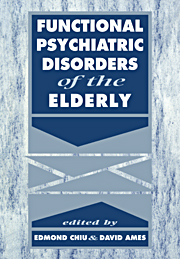Book contents
- Frontmatter
- Contents
- List of contributors
- Preface
- Introduction – A personal note
- Acknowledgement
- Part 1 Classification
- Part 2 General epidemiology
- Part 3 Neuroses
- Part 4 Affective disorders
- Part 5 Psychosexual disorders
- Part 6 Substance use and abuse
- Part 7 Schizophrenia and related psychoses
- Part 8 Psychological, biological and medical issues
- Part 9 Treatment methods
- 25 Geriatric psychopharmacology
- 26 Electroconvulsive therapy in later life
- 27 Family therapy
- 28 Group therapy in the elderly
- 29 Integrated psychotherapy of the elderly
- 30 Management of the treatment team in a multidisciplinary framework
- 31 Occupational therapy
- 32 Nursing management
- 33 Social work and the psychiatry of late life
- 34 Music therapy
- 35 Physiotherapy
- Part 10 Conclusion
- Index
27 - Family therapy
from Part 9 - Treatment methods
Published online by Cambridge University Press: 13 November 2009
- Frontmatter
- Contents
- List of contributors
- Preface
- Introduction – A personal note
- Acknowledgement
- Part 1 Classification
- Part 2 General epidemiology
- Part 3 Neuroses
- Part 4 Affective disorders
- Part 5 Psychosexual disorders
- Part 6 Substance use and abuse
- Part 7 Schizophrenia and related psychoses
- Part 8 Psychological, biological and medical issues
- Part 9 Treatment methods
- 25 Geriatric psychopharmacology
- 26 Electroconvulsive therapy in later life
- 27 Family therapy
- 28 Group therapy in the elderly
- 29 Integrated psychotherapy of the elderly
- 30 Management of the treatment team in a multidisciplinary framework
- 31 Occupational therapy
- 32 Nursing management
- 33 Social work and the psychiatry of late life
- 34 Music therapy
- 35 Physiotherapy
- Part 10 Conclusion
- Index
Summary
Introduction
This chapter begins with the definitions of family therapy, gives an overview of the complex historical developments of the family therapy field, discusses the meager literature on the applications of family therapy to the elderly and ends with suggestions as to how the practitioner can apply family therapy concepts in their daily work. The chapter reflects the thinking of the two authors, who have been collaborating over the last three years in a project introducing family therapy into a geriatric psychiatry service.
The term family therapy can be used to describe interventions that can be added to other treatments within the framework of the biomedical model or the term can be used to describe an alternative model of helping people with problems. Family therapy as alternative model is also called the system or systemic model and it assumes that, to understand and help the older person with symptoms and signs of a functional psychiatric disorder, the clinician should have an understanding of the way symptoms and signs in an individual can be influenced by, and in turn influence interactions, behaviors and beliefs in other people, particularly in the family.
To clarify this distinction, it is useful to make the assumption that communications made by people can be understood in different ways.
Biomedical model
A clinician using the biomedical model, listening to an account given by an older person or one of their relatives would be listening for evidence and watching for behavior that helps them to decide what is wrong with the person.
- Type
- Chapter
- Information
- Functional Psychiatric Disorders of the Elderly , pp. 461 - 477Publisher: Cambridge University PressPrint publication year: 1994



